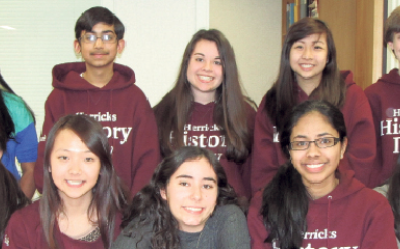
Herricks High School students know history.
The Highlanders demonstrated that ability in taking 11 of the top spots in the five presentation categories in the recent History Day competition at Hofstra University.
The results gave Herricks more wins in the regional competition than any other school district on Long Island.
“On the secondary level, we’ve dominated Long Island for the past 11 years,” said Melissa Jacobs, faculty co-advisor with Samantha Garantabee of the high school Historical Research Club.
In this year’s contest, the school’s success spread to Herricks Middle School where eighth grader Rachel Kim scored a win in the individual performance category.
The winning students, who will now take their projects to state competition in Cooperstown this month, had been preparing after school and at home since January up until the date of the competition on March 10.
“They put a lot of hours into it,” Jacobs said. “They can take ownership of the project.”
Freshman Arianna Ramdass took top honors in the senior individual category with her documentary “From Feast to Famine: The Potato as a Turning Point in History.”
Ramdass said working on her project was an academic turning point for her since she really didn’t have much interest in history before.
She said she also didn’t expect her nine-minute, 30-second documentary to take top honors.
“I didn’t really think about the potato that much before,” Ramdass said. “I focused on the turning point when it was brought to Europe.”
Junior Marielle Lenowitz came up with the idea for the winning project in the senior group exhibit category when her father told her about the 1967 riots in Detroit.
“Our exhibit focused on how the city changed,” said Lenowitz, who developed the exhibit with junior Ashley Skaria and sophomores Gina Yoo and Lauren Paik.
The project, “Detroit Burning,” presented the story of the underlying racial tension and a police brutality in the city that sparked the destructive riots. The students prepared three panels of text and photographs delineating the Detroit before the riots that some described as the “Paris of the Midwest,” the impact of the riots themselves that suddenly turned Detroit into one of the most dangerous cities in America and the aftermath of the riots.
“Before the riots, Detroit was one of the most powerful cities in America. The riots sparked a decline in the city,” Yoo said. “It required an insane amount of research.”
Taking second place in the senior group exhibit category, senior Kristen Bianco and her history team partners Grace Neuman, Jeffrey Kim and Khusbu Patel presented “Without A Trace,” an examination of the infamous kidnapping of aviator Charles Lindbergh’s infant son.
“It was very interesting. It was morbid and very sad,” she said of the historical incident.
The Lindbergh group prepared a three-panel exhibit designed as a newsstand to reflect the media frenzy that the kidnapping produced at the time.
One panel presented material about the kidnapping itself, including a ladder evoking the one used in the crime. The other panels presented information about the sensation trial and the after-effects of the crime, which helped to make kidnapping a federal crime.
“Lindbergh brought it into the media and made people care about his baby. Then the federal government got involved,” Bianco said.
Senior Corrin Chow, president of the Historical Research Club, focused on the social and implications of Sugar in the group project she worked on with Kadambari Suri and Madeline Huang. Their project won third place in the group exhibit competition.
“We looked at the economic view. We had slavery and imperialism as the result of the sugar trade,” Huang said.
A circular display of rotating panels presented material on the business of the sugar trade, the slave labor that supported it and the imperialism that maintained the cycle as demand for what Chow called the “white gold” grew.
“The high demand for sugar led to a high demand for forced labor,” she said.
Freshman Joshua Somrah built a scale model of the U.S. Supreme Court that stands six feet tall for his second place senior individual exhibit on Engel v. Vitale, a case about prayer in school that originated in the Herricks School District in 1959.
The fact of Herricks’ involvement sparked Somrah’s interest when he did the research about the case that involved Jewish families filing suit to stop the required Regents prayer practice.
“Their children were being persecuted for not praying,” Somrah said.
Beyond the state competition in Cooperstown this month, a national history competition is the final stage in Washington, D.C. in June.
Other Herricks winners included:
Group documentary: 1st place – Diane Li, Kerianne DiBattista for “The Iron Underground: From the IRT to the MTA”
4th place – Tafheem Nayeem, Rifah Rashid for “The Middle East Mandates
Group Performance: 2nd Place – Sahil Rawal, Tanzim Bhuyia ,Jugal Joshi, Abhinav Talwar for “Jury Nullification”
3rd Place – Linda Mule, Nicole Chanpour and Lindsay Slavit for “SAT”
Individual Documentary – 3rd Place – Justin Senzer for “Land Grants”
Individual Exhibit – 3rd Place Vikram Krshnamoorthy for “The War That Never Was”






